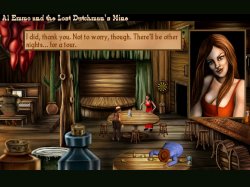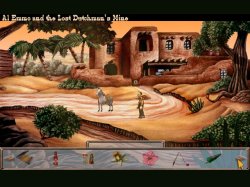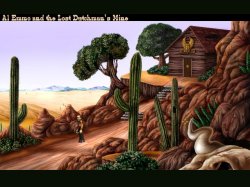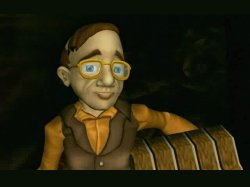|
Al Emmo and the Lost Dutchman's Mine
 Not long ago in a recent editorial I was lamenting the dearth of humorous adventure games in the traditional style. Then along comes Al Emmo and the Lost Dutchman's Mine to show that this type of game isn't forgotten. Though clearly inspired by the Sierra classics, the developers (Himalaya Studios) have built upon that firm bedrock and produced a game that sparkles with originality, humour, and poignancy.
The unlikely hero of this story, Al Emmo, doesn't have a lot going for him apart from an earnest naivete. For a start he's a short, paunchy, bespectacled 42 year old who still lives with his mom and dad and relies on them for his allowance. He's also balding with a terrible comb-over.
Oh, and he resembles Woody Allen.
In the biggest move of his life he descends from the train in the dry desert town of Anozira to marry the woman of his dreams whom he read about in a mail-order magazine. Al is confident that he has everything that such a woman could want, except a generous cash flow. Jilted and despondent for all of five minutes, Al soon meets the young and beautiful Rita Peralto whose father perished two years earlier while searching for a lost Aztec treasure. Al sets out to woo the new woman of his dreams. But he is not alone in that particular quest. Not long ago in a recent editorial I was lamenting the dearth of humorous adventure games in the traditional style. Then along comes Al Emmo and the Lost Dutchman's Mine to show that this type of game isn't forgotten. Though clearly inspired by the Sierra classics, the developers (Himalaya Studios) have built upon that firm bedrock and produced a game that sparkles with originality, humour, and poignancy.
The unlikely hero of this story, Al Emmo, doesn't have a lot going for him apart from an earnest naivete. For a start he's a short, paunchy, bespectacled 42 year old who still lives with his mom and dad and relies on them for his allowance. He's also balding with a terrible comb-over.
Oh, and he resembles Woody Allen.
In the biggest move of his life he descends from the train in the dry desert town of Anozira to marry the woman of his dreams whom he read about in a mail-order magazine. Al is confident that he has everything that such a woman could want, except a generous cash flow. Jilted and despondent for all of five minutes, Al soon meets the young and beautiful Rita Peralto whose father perished two years earlier while searching for a lost Aztec treasure. Al sets out to woo the new woman of his dreams. But he is not alone in that particular quest.
 The introduction beautifully sets the scene and ends with Al penniless and stuck in Anozira, having just missed the only train out of town. Al needs to get some money and find a place to stay, and this is your cue for exploring the area and talking to everyone you meet. Playing as Al you are not completely alone for an omniscient and pompous narrator will accompany you through eight of the nine acts of the game, providing descriptions that are sometimes useful, sometimes not. He will also comment disparagingly on Al's appearance and belittle his efforts to do even the most mundane of tasks. Clearly Al will need to find friends elsewhere.
Al Emmo and the Lost Dutchman's Mine is a third person perspective adventure set in the old Wild West. If you've played a traditional adventure game before you'll be right at home here. If not don't worry, because the interface is designed to make moving around and interacting with the game as easy as possible. Clicking the right mouse button cycles through the familiar action icons such as look, talk, take and walk. You can use the mouse to interact with anyone and anything. And I do mean anything. Left click the cross hair icon on screen and Al will walk to that spot if he can. Double click and he'll run. If you want Al to move around really quickly you can start him walking and press the Esc key and he'll jump to that point or to any one of the many exits available throughout the game. Later, if you search carefully you may find a really useful map for 'teleporting' to key places you have previously visited. All these features ensure that the necessary to-ing and fro-ing as you explore is as painless as possible. The introduction beautifully sets the scene and ends with Al penniless and stuck in Anozira, having just missed the only train out of town. Al needs to get some money and find a place to stay, and this is your cue for exploring the area and talking to everyone you meet. Playing as Al you are not completely alone for an omniscient and pompous narrator will accompany you through eight of the nine acts of the game, providing descriptions that are sometimes useful, sometimes not. He will also comment disparagingly on Al's appearance and belittle his efforts to do even the most mundane of tasks. Clearly Al will need to find friends elsewhere.
Al Emmo and the Lost Dutchman's Mine is a third person perspective adventure set in the old Wild West. If you've played a traditional adventure game before you'll be right at home here. If not don't worry, because the interface is designed to make moving around and interacting with the game as easy as possible. Clicking the right mouse button cycles through the familiar action icons such as look, talk, take and walk. You can use the mouse to interact with anyone and anything. And I do mean anything. Left click the cross hair icon on screen and Al will walk to that spot if he can. Double click and he'll run. If you want Al to move around really quickly you can start him walking and press the Esc key and he'll jump to that point or to any one of the many exits available throughout the game. Later, if you search carefully you may find a really useful map for 'teleporting' to key places you have previously visited. All these features ensure that the necessary to-ing and fro-ing as you explore is as painless as possible.
 One of the things I've missed in many recent adventure games is the ability to interact with everything and really slip right into a game world. There are no such problems here as just about everything you try will elicit a response. Even trying things that can't possibly work have generally been pre-empted by the developers who clearly understand what makes the humorous adventure so much fun to play. Depending on what you do, you might get a witty description, a scathing comment, a clue, or maybe an Easter Egg as a reward. Even doing blatantly silly things may get a response. For example, try some wacky interacting with various objects at the station and you just may get a surprise. No doubt you will discover other Easter Eggs for yourself, but the point remains, if you don't try you'll never know.
With so much feedback Al Emmo and the Lost Dutchman's Mine is designed to encourage experimentation. It's been so long since I had played this type of game that initially I was quite rusty and had forgotten many of the ways that you can find out about things. For example, you can show every inventory item to other characters to learn what they can tell you about them. It's entertaining listening to the different responses to various objects, especially as the descriptions cleverly change in keeping with the proclivities of the character you are consulting. Sometimes they provide a clue as to an item's possible use that might just trigger that 'aha' moment. Sometimes not. And don't forget that you can also use items on Al for his response. If you just follow the obvious paths you'll miss so much of the richness that is hidden behind the scenes. One of the things I've missed in many recent adventure games is the ability to interact with everything and really slip right into a game world. There are no such problems here as just about everything you try will elicit a response. Even trying things that can't possibly work have generally been pre-empted by the developers who clearly understand what makes the humorous adventure so much fun to play. Depending on what you do, you might get a witty description, a scathing comment, a clue, or maybe an Easter Egg as a reward. Even doing blatantly silly things may get a response. For example, try some wacky interacting with various objects at the station and you just may get a surprise. No doubt you will discover other Easter Eggs for yourself, but the point remains, if you don't try you'll never know.
With so much feedback Al Emmo and the Lost Dutchman's Mine is designed to encourage experimentation. It's been so long since I had played this type of game that initially I was quite rusty and had forgotten many of the ways that you can find out about things. For example, you can show every inventory item to other characters to learn what they can tell you about them. It's entertaining listening to the different responses to various objects, especially as the descriptions cleverly change in keeping with the proclivities of the character you are consulting. Sometimes they provide a clue as to an item's possible use that might just trigger that 'aha' moment. Sometimes not. And don't forget that you can also use items on Al for his response. If you just follow the obvious paths you'll miss so much of the richness that is hidden behind the scenes.
 As you may have guessed by now the puzzles are largely inventory-based where you need to find items and use them appropriately, or inappropriately, as the case may be. Many of the obstacles to progress involve getting hold of needed items in convoluted and ingenious ways. The solutions aren't always immediately obvious but listening to other characters, or examining an item will surely give you a clue. In addition to the inventory puzzles a variation on Wak-A-Rat makes a return (I had a good chuckle here) and the last act also throws in a simple sliding tile puzzle, a quiz, and a couple of physical or movement puzzles that involve an element of timing. The latter may be a little frustrating until you work out what you need to do, but there's no need to worry if you fail as the game allows you to be quickly restored to try again.
So, Al Emmo and the Lost Dutchman's Mine is a fun and entertaining game where you need your wits about you. I smiled, chuckled, and sometimes laughed out loud as I played along. Though I did think the sexual innuendo was laid on a little too thickly in Act 4, but that's a matter of taste. Unfortunately it does stamp the game as 'unsuitable for children' which is a bit of a shame. As you may have guessed by now the puzzles are largely inventory-based where you need to find items and use them appropriately, or inappropriately, as the case may be. Many of the obstacles to progress involve getting hold of needed items in convoluted and ingenious ways. The solutions aren't always immediately obvious but listening to other characters, or examining an item will surely give you a clue. In addition to the inventory puzzles a variation on Wak-A-Rat makes a return (I had a good chuckle here) and the last act also throws in a simple sliding tile puzzle, a quiz, and a couple of physical or movement puzzles that involve an element of timing. The latter may be a little frustrating until you work out what you need to do, but there's no need to worry if you fail as the game allows you to be quickly restored to try again.
So, Al Emmo and the Lost Dutchman's Mine is a fun and entertaining game where you need your wits about you. I smiled, chuckled, and sometimes laughed out loud as I played along. Though I did think the sexual innuendo was laid on a little too thickly in Act 4, but that's a matter of taste. Unfortunately it does stamp the game as 'unsuitable for children' which is a bit of a shame.
The byplay between Al and the narrator is a humorous and effective feature not seen since games like Space Quest VI: The Spinal Frontier. The unseen narrator with his persistent commentary becomes as important a character as any in the game. The voice acting generally carries off the roles very well with Al (voiced by Chris Warren), in particular, having a slightly annoying reedy whine that is nicely suited to his character. John Bell provides the voice of the narrator and several other characters, and he seems to have found a comfortable niche in lending his voice to adventure games. My only (minor) complaint here is that some characters sounded too similar at times. You can play the game with voices only, or text only, or with both voices and text.
The hand painted backgrounds set the scene for this wild west adventure and are reminiscent of the Sierra games with character portraits popping up during conversations. Dust devils animate the western locations that are populated with every known species of cacti, and then some, about the only thing missing was tumbling tumbleweed to complete the effect. Though it has to be said that the presence of a Wombat more than makes up for this. The 3D cut scenes are very well done as are the dramatic comic book style transitions at the end of some acts. The original music by Quest Studios is excellent and really captures that western flavour.
Himalaya Studios honed their skills with their popular remakes of King's Quest I and II. With Al Emmo and the Lost Dutchman's Mine they show that they also have what it takes to create a successful original work. If, like me, you're looking for a fun-filled adventure game, with plenty of things to do, then don't miss this one. May Himalaya Studios make many more.
You can purchase this adventure game at the Himalaya Studios Website.
See the metzomagic.com Al Emmo walkthrough.
Copyright © Gordon Aplin 2006.
All rights reserved.
System Requirements:
Pentium or higher processor (800 Mhz or above required), Windows 95 OSR2, 98, ME, 2000, or XP, 128 MB RAM, DirectX-compatible video card which supports SVGA display and 32-bit graphics, 1 MB Video RAM required (2 MB recommended), DirectX 5 or above (DirectX 9.0c recommended), Approximately 350 MB free disk space, DirectX-compatible digital sound card
|

